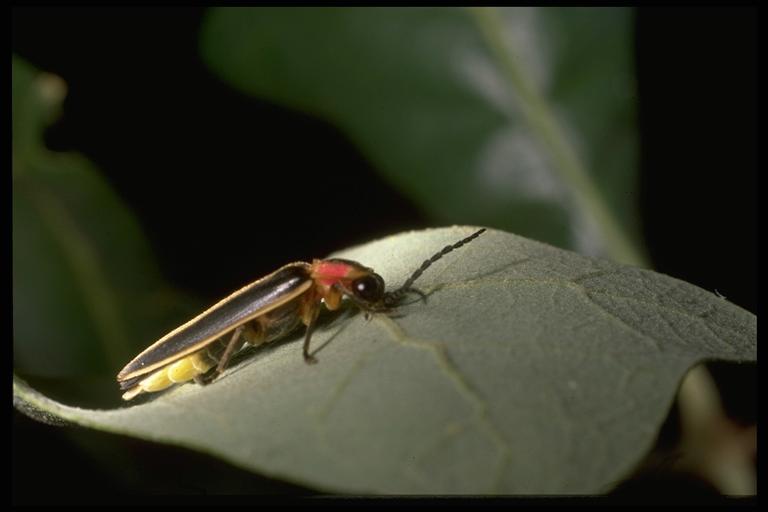
A firefly, Photinus sp. (Coleoptera: Lampyridae). Photo by Drees.
Common Name: Firefly
Scientific Name: Photinus sp.
Order: Coleoptera
Description: These insects are more accurately called “lightning beetles” because they are neither flies (Diptera) nor true bugs (Hemiptera). Adults of the woods firefly, Photuris pennsylvanicus DeGeer, common in Texas, are long and narrow, about ½- inch long with a black head, a reddish section behind the head with dark middle marking (prothorax) and flexible dark brown wing covers (elytra) edged with yellow. Their most notable feature is the underside of the abdomen with the last number of segments colored greenish-yellow, forming a “tail light” capable of producing flashes of light. Larvae are flattened, spindle-shaped and have shield-like segments. Females of some species are wingless and appear similar to larvae. Wingless females and many larvae also have structures that produce light, and are called, “glow worms.”
Few other insects can be confused with lightningbugs because no other insect possess the light-producing structures on their abdomens, although some click beetles (Coleoptera: Elateridae) also have light-producing structures on their bodies. However, some of the soldier beetles such as Chaulognathus pennsylvanicus (DeGeer) (Coleoptera: Cantharidae) superficially resemble lightningbugs in body shape. These beetles are 1/2 inch long, yellow with a black marking on each wing cover (elytra).
Life Cycle: Winter is spent in the larval stage in chambers formed in the soil. They pupate in the spring and emerge in early summer. After mating females lay spherical eggs singly or in groups in damp soil. Larvae hatch from eggs in about 4 weeks and larvae develop through several stages (instars) before pupating. The life cycle of most species takes two years.
Habitat and Food Source(s): Mouthparts are for chewing. Immature stages of lightning beetles are predatory on other small insects, earthworms, slugs and snails. Adults of some species are also predatory. Larvae and adults are active at night (they are nocturnal), and immobilize their prey by injecting them with inject toxic digestive enzymes before sucking out the liquefied body contents. Adults produce light to find mates and some species use light to attract other species of lightning bugs as prey. The light produced by lightning beetles gives off no heat and is produced by the reaction of two substances (luciferin and the enzyme, luciferase). Adults of some species apparently do not feed. Common in open areas near woods. Lightning beetles can be found in early summer (late May) beginning at dusk when they illuminate.
Pest Status: Predatory larvae; medically harmless.
For additional information, contact your local Texas A&M AgriLife Extension Service agent or search for other state Extension offices.
Literature: Borror et al. 1989; Metcalf et al. 1962. Swan & Papp 1972.